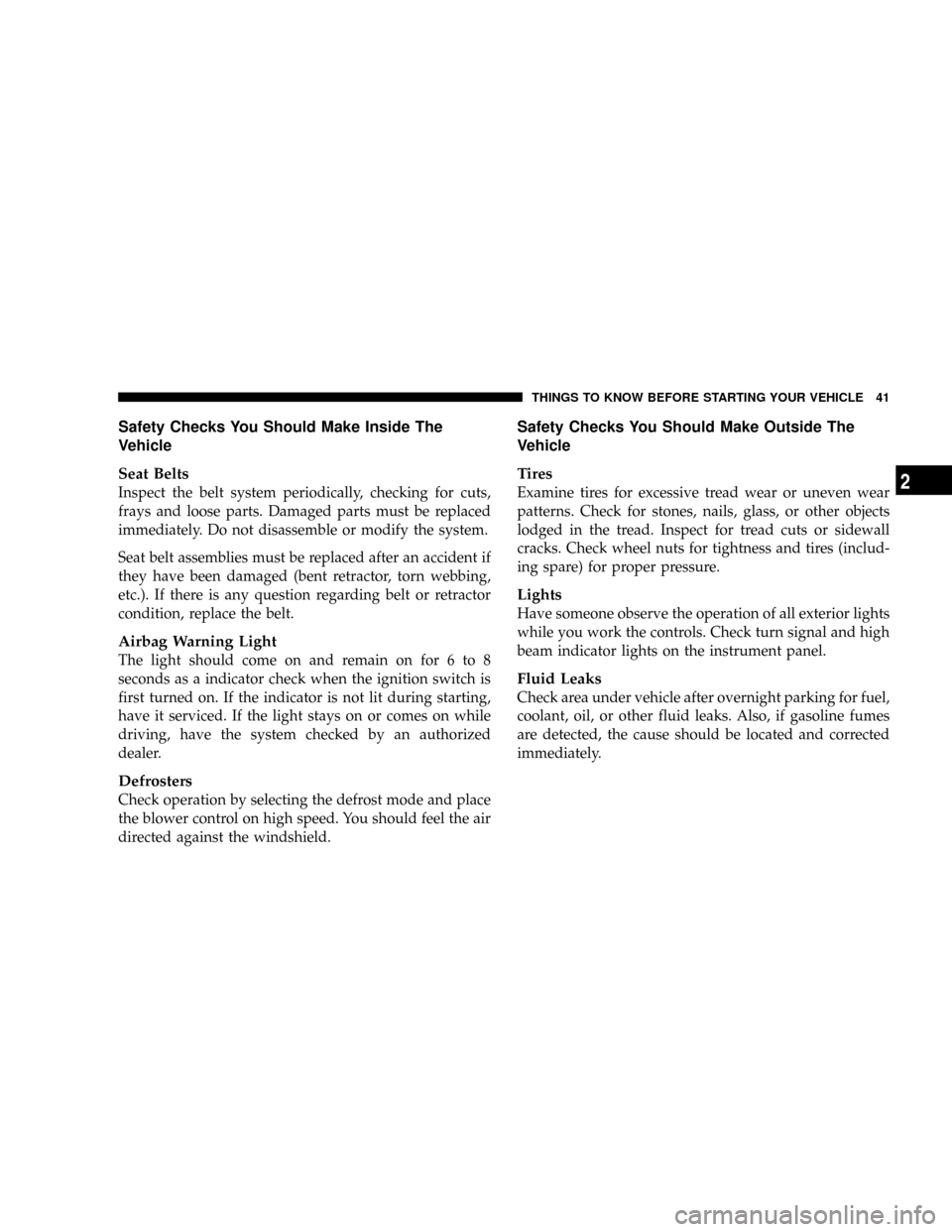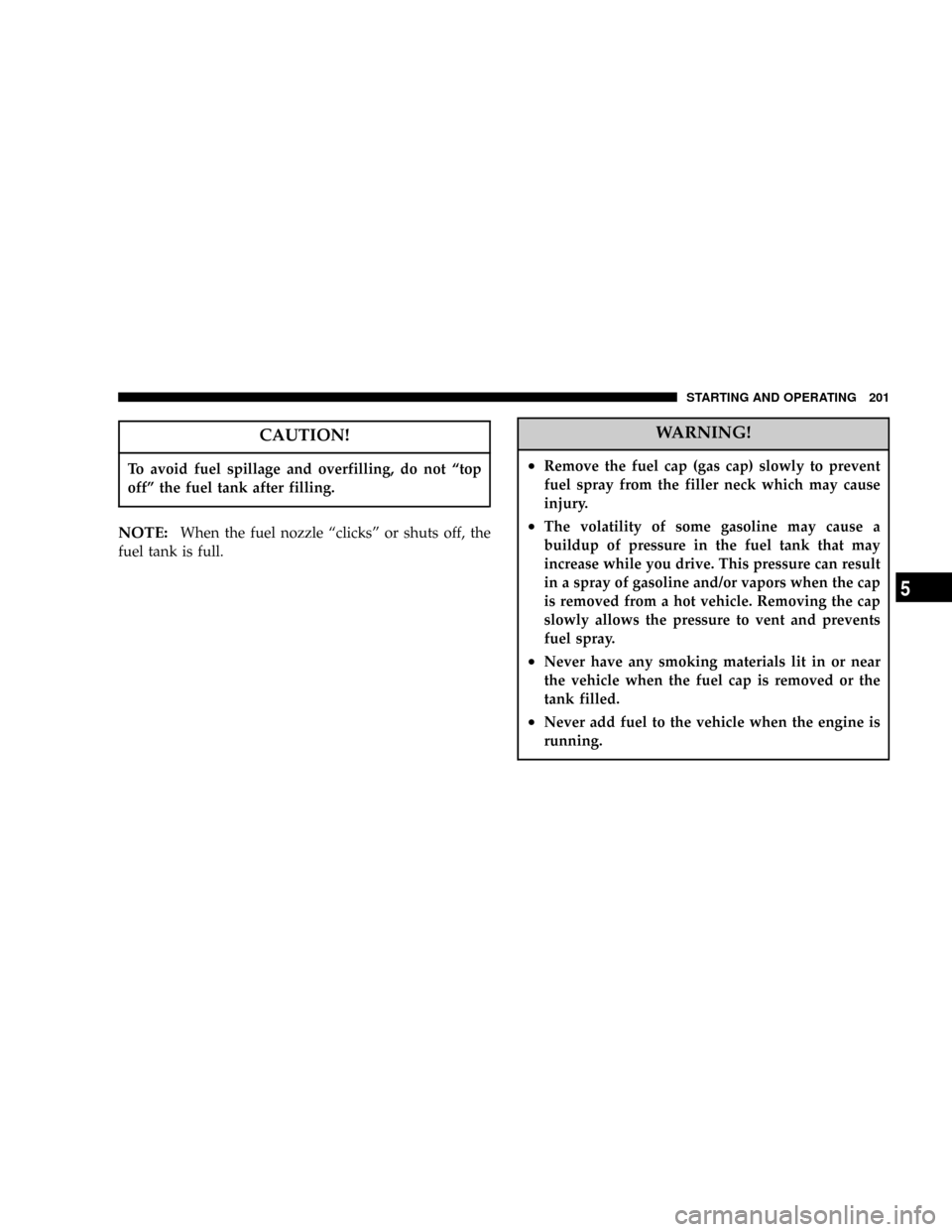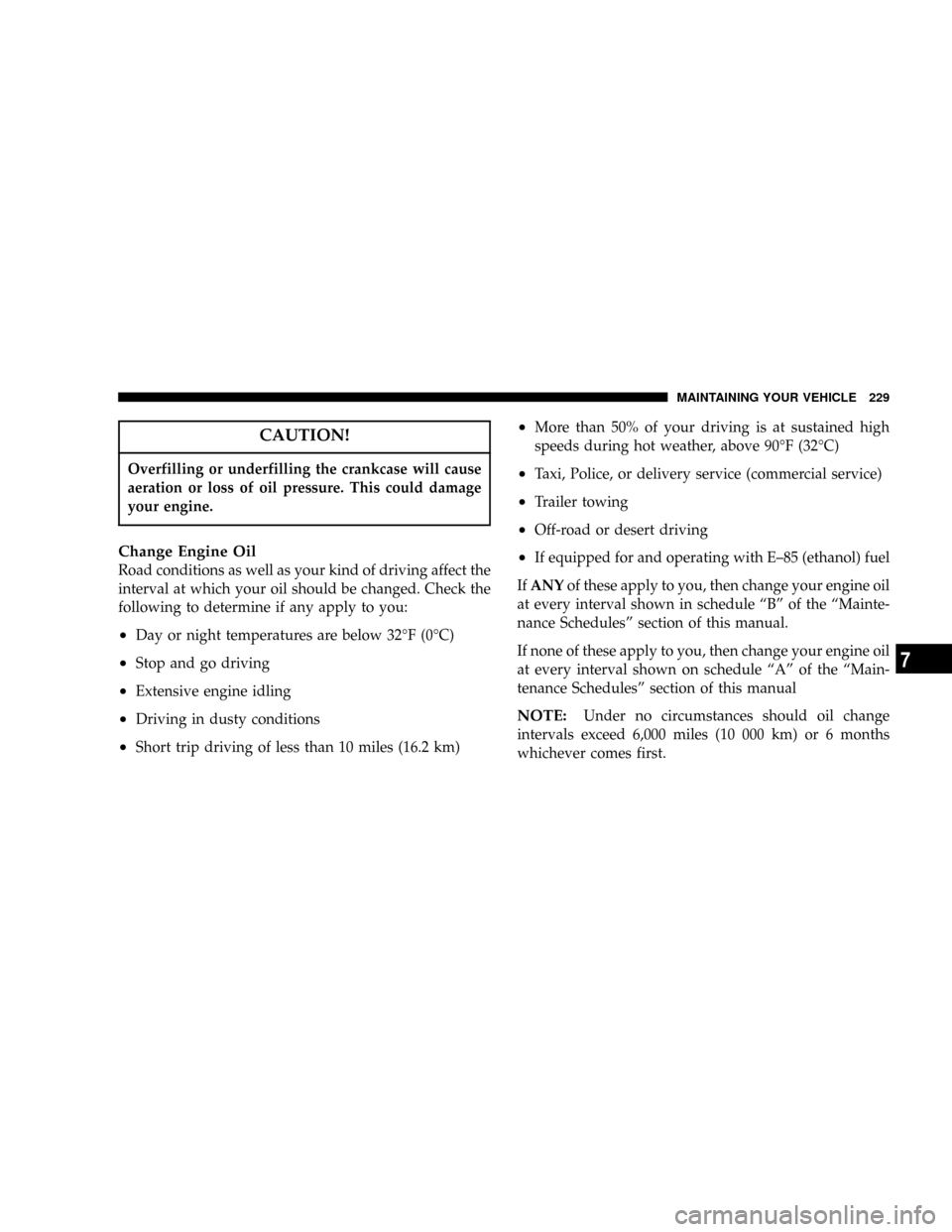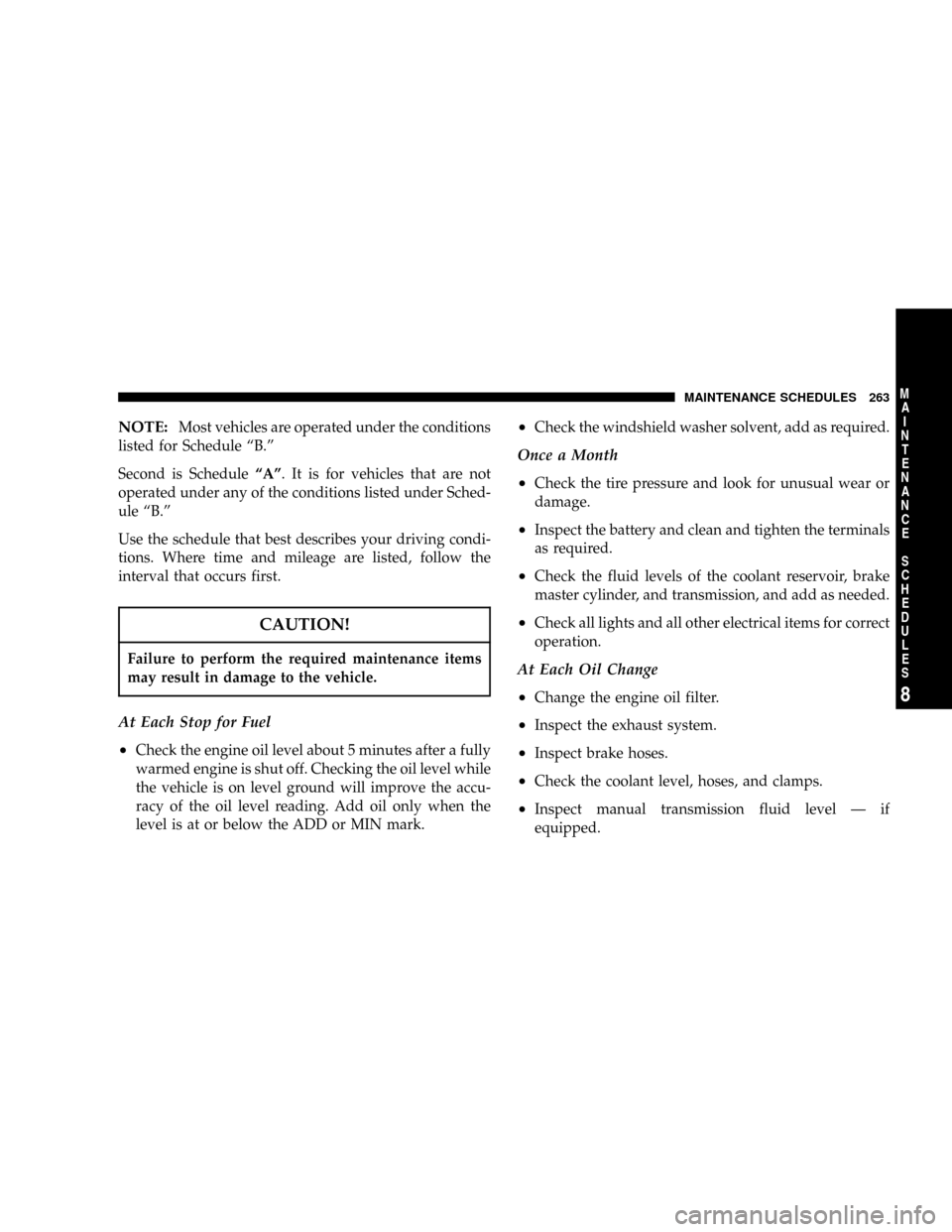fuel pressure JEEP WRANGLER 2004 TJ / 2.G Owners Manual
[x] Cancel search | Manufacturer: JEEP, Model Year: 2004, Model line: WRANGLER, Model: JEEP WRANGLER 2004 TJ / 2.GPages: 299, PDF Size: 6.82 MB
Page 41 of 299

Safety Checks You Should Make Inside The
Vehicle
Seat Belts
Inspect the belt system periodically, checking for cuts,
frays and loose parts. Damaged parts must be replaced
immediately. Do not disassemble or modify the system.
Seat belt assemblies must be replaced after an accident if
they have been damaged (bent retractor, torn webbing,
etc.). If there is any question regarding belt or retractor
condition, replace the belt.
Airbag Warning Light
The light should come on and remain on for 6 to 8
seconds as a indicator check when the ignition switch is
first turned on. If the indicator is not lit during starting,
have it serviced. If the light stays on or comes on while
driving, have the system checked by an authorized
dealer.
Defrosters
Check operation by selecting the defrost mode and place
the blower control on high speed. You should feel the air
directed against the windshield.
Safety Checks You Should Make Outside The
Vehicle
Tires
Examine tires for excessive tread wear or uneven wear
patterns. Check for stones, nails, glass, or other objects
lodged in the tread. Inspect for tread cuts or sidewall
cracks. Check wheel nuts for tightness and tires (includ-
ing spare) for proper pressure.
Lights
Have someone observe the operation of all exterior lights
while you work the controls. Check turn signal and high
beam indicator lights on the instrument panel.
Fluid Leaks
Check area under vehicle after overnight parking for fuel,
coolant, oil, or other fluid leaks. Also, if gasoline fumes
are detected, the cause should be located and corrected
immediately.
THINGS TO KNOW BEFORE STARTING YOUR VEHICLE 41
2
Page 117 of 299

7. High Beam Indicator Light
This light shows that the headlights are on high
beam. Pull the turn signal lever towards the
steering wheel to switch the headlights from high or
low. If the driver's door is open, and the headlights or
parklights are left on, the ªHigh Beam Indicator Lightº
will flash and a chime will sound.
8. Seat Belt Indicator Light
A warning chime and an indicator light will
alert you to buckle the seat belts. When the belt
is buckled, the chime will stop, but the light will
stay on until it times out (about 6 seconds).
9. Speedometer
Indicates vehicle speed.
10. Front Axle Lock Indicator Light Ð If Equipped
Indicates when the front axle lock has been
activated.11. Rear Axle Lock Indicator Light Ð If Equipped
Indicates when the rear axle lock has been
activated.
12. 4WD Indicator Light
This light alerts the driver that the vehicle is
in the four-wheel drive mode, and the front
and rear driveshafts are mechanically locked
together forcing the front and rear wheels to
rotate at the same speed.
13. Shift Indicator Light Ð If Equipped
This light shows the driver when to shift to the
next higher gear for best fuel economy (4.0L
Only).
14. Oil Pressure Gauge
Indicates engine oil pressure. This gauge does
not indicate oil level, and pressure varies with
engine speed, temperature and oil viscosity. Consis-
tent lower readings indicate possible malfunction.
Seek authorized service.
UNDERSTANDING YOUR INSTRUMENT PANEL 117
4
Page 118 of 299

15. Coolant Temperature Gauge
Indicates engine coolant temperature. The red
zone to the far right indicates possible overheat-
ing. Seek authorized service immediately if the
gauge operates in the red zone. In U.S. vehicles,
temperature is indicated in degrees fahrenheit; in
Canadian vehicles in degrees centigrade.
16. Airbag Warning Light
This indicator lights and remains lit for 6 to
8 seconds when the ignition is first turned
on. If the light does not come on for 6 to 8
seconds, stays on or comes on while driving,
have the airbag system checked by an authorized
dealer.
17. Check Gauges Warning Light
This light monitors the engine coolant tem-
perature, engine oil pressure, and voltage
gauges. If it detects an extreme condition a
chime will sound and the light will come on. If the
light comes on, check the operation of these gauges for
a malfunction condition.18. Malfunction Indicator Light
This light is a part of an Onboard Diagnostic
System called OBD II that monitors engine,
and automatic transmission control systems.
The light will illuminate when the ignition is in the
ON position before engine start. If the bulb does not
come on when turning the key from OFF to ON, have
the condition checked promptly.
Certain conditions such as a loose or missing gas cap,
poor quality fuel, etc. may illuminate the light after
engine start. The vehicle should be serviced if the light
stays on through several typical driving styles. In most
situations, the vehicle will drive normally and will not
require towing.
When the engine is running, the ªMalfunction Indicator
Lightº may flash to alert serious conditions that could
lead to immediate loss of power or severe catalytic
converter damage. The vehicle should be serviced as
soon as possible if this occurs.
118 UNDERSTANDING YOUR INSTRUMENT PANEL
Page 120 of 299

If the parking brake is applied and the vehicle is in
motion, the red BRAKE warning light will ªflashº and a
chime will sound.
The operation of the BRAKE warning light can be
checked by turning the ignition switch from the OFF
position to the ON position. The light should illuminate
for approximately two seconds. The light should then
turn off unless the parking brake is applied or a brake
fault is detected. If the light does not illuminate, have the
light inspected by an authorized dealer.
23. Low Fuel Warning Light
When the fuel level reaches approximately 2 U.S.
Gallons (7.6L) this light will come on and remain
on until fuel is added. The ªLow Fuel Warning
Lightº may turn on and off again, especially during
and after hard braking, accelerations, or turns. This
occurs due to the shifting of the fuel in the tank.
24. Fuel Cap Indicator
This symbol indicates the side of the vehicle
where the fuel cap is located.25. Fuel Gauge
The pointer shows the level of fuel in the fuel tank. When
the fuel gauge pointer initially moves to E, for your
safety, approximately 2 U.S. Gallons (7.6L) of fuel remain.
NOTE:When the ignition switch is turned to OFF, the
fuel gauge, voltmeter, oil pressure and temperature
gauges may not show accurate readings. When the
engine is not running, turn the ignition switch to ON to
obtain accurate readings.
ELECTRONIC DIGITAL CLOCK
The clock and radio each use the display panel built into
the radio. A digital readout shows the time in hours and
minutes whenever the ignition switch is in the ON or
ACC position and the time button is pressed.
When the ignition switch is in the OFF position, or when
the radio frequency is being displayed, time keeping is
accurately maintained.
120 UNDERSTANDING YOUR INSTRUMENT PANEL
Page 158 of 299

mOff-Road Driving Tips..................181
NWhen To Use Low Range...............181
NIn Snow, Mud And Sand................181
NHill Climbing........................182
NTraction Downhill.....................183
NAfter Driving Off-Road.................183
mTire Safety Information..................184
NTire Markings........................184
NTire Identification Number (TIN)..........187
NTire Loading And Tire Pressure...........188
mTires Ð General Information..............191
NTire Pressure.........................191
NTire Inflation Pressures.................192
NHigh Speed Operation.................193
NRadial-Ply Tires......................193NTire Spinning........................193
NTread Wear Indicators..................194
NReplacement Tires.....................194
NAlignment And Balance.................195
mTire Chains...........................196
mTire Rotation Recommendations...........196
mFuel Requirements.....................197
NReformulated Gasoline.................198
NGasoline/Oxygenate Blends..............198
NMMT In Gasoline.....................198
NSulfur In Gasoline.....................199
NMaterials Added To Fuel................199
mFuel Filler Cap (Gas Cap)................200
NLocking Fuel Filler Cap (Gas Cap) Ð
If Equipped.........................202
158 STARTING AND OPERATING
Page 192 of 299

2. EconomyÐ
Improper inflation pressures can cause uneven wear
patterns to develop across the tire tread. These abnormal
wear patterns will reduce tread life resulting in a need for
earlier tire replacement. Under inflation also increases
tire rolling resistance and results in higher fuel consump-
tion.
3. Ride Comfort and Vehicle StabilityÐ
Proper tire inflation contributes to a comfortable ride.
Over inflation produces a jarring and uncomfortable ride.
Both under inflation and over inflation affect the stability
of the vehicle and can produce a feeling of sluggish
response or over-responsiveness in the steering.
Unequal tire pressures can cause erratic and unpredict-
able steering response.
Unequal tire pressure from side to side may cause the
vehicle to drift left or right.
Tire Inflation Pressures
The proper cold tire inflation pressure is located on the
lower driver's side instrument panel.
The tire pressure should be checked and adjusted at least
once every month. Check more often if subject to a wide
range of outdoor temperatures, as tire pressures vary
with temperature changes.
Inflation pressures specified on the label are always
ªCold Inflation Pressure.º Cold inflation pressure is
defined as the tire pressure after the vehicle has been idle
for at least 3 hours, or driven less than a mile after a 3
hour period. The cold inflation pressure must not exceed
the maximum values molded into the tire sidewall.
Tire pressures may increase from 13 to 40 kPa (2 to 6 psi)
[0.138 to 0.414 bar] during operation. DO NOT reduce
this normal pressure buildup.
192 STARTING AND OPERATING
Page 201 of 299

CAUTION!
To avoid fuel spillage and overfilling, do not ªtop
offº the fuel tank after filling.
NOTE:When the fuel nozzle ªclicksº or shuts off, the
fuel tank is full.
WARNING!
²Remove the fuel cap (gas cap) slowly to prevent
fuel spray from the filler neck which may cause
injury.
²The volatility of some gasoline may cause a
buildup of pressure in the fuel tank that may
increase while you drive. This pressure can result
in a spray of gasoline and/or vapors when the cap
is removed from a hot vehicle. Removing the cap
slowly allows the pressure to vent and prevents
fuel spray.
²Never have any smoking materials lit in or near
the vehicle when the fuel cap is removed or the
tank filled.
²Never add fuel to the vehicle when the engine is
running.
STARTING AND OPERATING 201
5
Page 229 of 299

CAUTION!
Overfilling or underfilling the crankcase will cause
aeration or loss of oil pressure. This could damage
your engine.
Change Engine Oil
Road conditions as well as your kind of driving affect the
interval at which your oil should be changed. Check the
following to determine if any apply to you:
²Day or night temperatures are below 32ÉF (0ÉC)
²Stop and go driving
²Extensive engine idling
²Driving in dusty conditions
²Short trip driving of less than 10 miles (16.2 km)
²More than 50% of your driving is at sustained high
speeds during hot weather, above 90ÉF (32ÉC)
²Taxi, Police, or delivery service (commercial service)
²Trailer towing
²Off-road or desert driving
²If equipped for and operating with E±85 (ethanol) fuel
IfANYof these apply to you, then change your engine oil
at every interval shown in schedule ªBº of the ªMainte-
nance Schedulesº section of this manual.
If none of these apply to you, then change your engine oil
at every interval shown on schedule ªAº of the ªMain-
tenance Schedulesº section of this manual
NOTE:Under no circumstances should oil change
intervals exceed 6,000 miles (10 000 km) or 6 months
whichever comes first.
MAINTAINING YOUR VEHICLE 229
7
Page 263 of 299

NOTE:Most vehicles are operated under the conditions
listed for Schedule ªB.º
Second is ScheduleªAº. It is for vehicles that are not
operated under any of the conditions listed under Sched-
ule ªB.º
Use the schedule that best describes your driving condi-
tions. Where time and mileage are listed, follow the
interval that occurs first.
CAUTION!
Failure to perform the required maintenance items
may result in damage to the vehicle.
At Each Stop for Fuel
²
Check the engine oil level about 5 minutes after a fully
warmed engine is shut off. Checking the oil level while
the vehicle is on level ground will improve the accu-
racy of the oil level reading. Add oil only when the
level is at or below the ADD or MIN mark.
²Check the windshield washer solvent, add as required.
Once a Month
²
Check the tire pressure and look for unusual wear or
damage.
²Inspect the battery and clean and tighten the terminals
as required.
²Check the fluid levels of the coolant reservoir, brake
master cylinder, and transmission, and add as needed.
²Check all lights and all other electrical items for correct
operation.
At Each Oil Change
²
Change the engine oil filter.
²Inspect the exhaust system.
²Inspect brake hoses.
²Check the coolant level, hoses, and clamps.
²Inspect manual transmission fluid level Ð if
equipped.
MAINTENANCE SCHEDULES 263
8
M
A
I
N
T
E
N
A
N
C
E
S
C
H
E
D
U
L
E
S
Page 291 of 299

Coolant Temperature Gauge............. 118
Engine Oil Pressure Gauge.............. 117
Jacking............................. 211
Jump Starting........................ 216
Emission Control System Maintenance....226,262
Engine
Air Cleaner.......................... 234
Block Heater......................... 162
Break-In Recommendations............... 39
Compartment........................ 224
Exhaust Gas Caution................... 40
Fails to Start......................... 161
Flooded, Starting..................... 161
Fuel Requirements.................197,258
Jump Starting........................ 216
Oil .............................228,258
Oil Disposal......................... 231
Oil Filter............................ 231
Oil Pressure Gauge.................... 117
Oil Selection......................... 258
Overheating......................... 210
Starting............................ 160
Temperature Gauge.................... 118Engine Oil Viscosity Chart................ 230
Entry System, Illuminated................. 15
Exhaust Gas Caution..................... 40
Exhaust System........................ 238
Extender, Seat Belt....................... 21
Exterior Finish Care..................... 249
Fabric Care........................250,252
Fabric Top............................ 250
Filters
Air Cleaner.......................... 234
Engine Fuel......................... 234
Engine Oil.......................... 231
Finish Care........................... 249
Flashers
Hazard Warning...................... 210
Turn Signal.......................... 116
Flooded Engine Starting.................. 161
Fluid Capacities........................ 258
Fluid Level Checks...................... 248
Automatic Transmission................ 245
Engine Oil.......................... 228
Manual Transmission.................. 247
INDEX 291
10